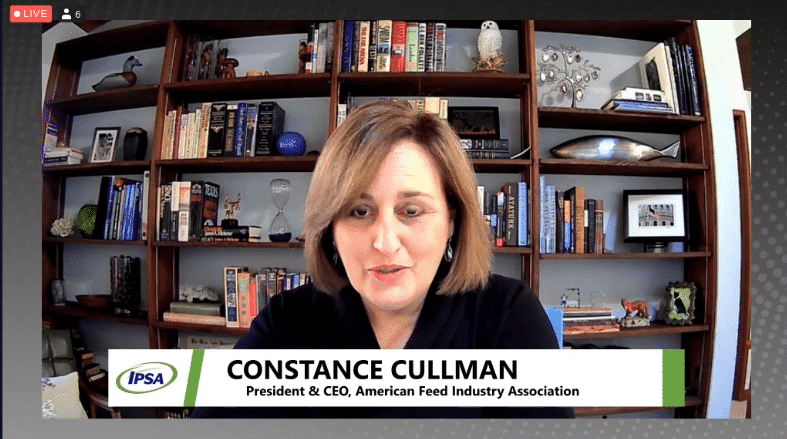We receive a Washington D.C. update just in time for Joe Biden to enter office.
Yesterday, Jan. 20, was a day that no one is soon to forget. Donald Trump, the 45th President of the United States, ended his term and President Joe Biden was inaugurated as the 46th President.
Of course, with a historic change of power, the question on everyone’s mind at the Independent Professional Seed Association’s (IPSA) Annual Conference was: what’s happening next in Washington D.C.?
Well, Constance Cullman, CEO of the American Feed Industry Association, was happy to give the annual Washington Update.
And her first update?
“Moments ago, on my TV in the background, President-Elect Joe Biden became President Joe Biden,” Cullman said. “But for right now, I want everyone to take a minute, take a deep breath and remember 2020.”
Cullman illustrated this by saying that we started the year with a crisis in Iran, and with an impeachment of a sitting president. There were trade tensions and ongoing trade agreements. COVID-19 was the first global pandemic since 1918, which swept across the U.S. There was the stock market decline, civil unrest, a battle for the presidency, the Senate and the state legislators. An even greater market crash — at 12.93% — than the Wall Street Crash of 1929.
“Let’s just be honest, 2020 was rough,” she said. “We were all breathless with anticipation when 2021 rolled around, and it’s been a tumultuous year already. And this is the backdrop for agricultural policy in Washington D.C. So, let’s take a look at the White House.”
Analyzing the White House
As Cullman mentioned, President Biden has officially taken office. In the election, we saw 306 electoral votes to 232, but when taking a look at those results, Cullman said it doesn’t show how much was up in the air because of mail in ballots. Of course, that caused plenty of tension in the U.S., but it was clear that Biden would be our next president.
“When we take a look at the presidential election in and of itself, the post-election turmoil was unprecedented,” she said. “We expected to see that the day of the vote, but we didn’t It was after the election that the turmoil revealed itself. It demonstrates that the U.S., quite frankly, is as divided as it has ever been. That means a lot when we talk about policy.”
Cullman said it’s this turmoil that President Biden now has to face.
“He’s facing a pandemic, a divided nation, social unrest, the largest federal debt, local economies in distress and — in a world much different than the vice presidency he left four years ago — fierce antagonism with Russia,” she said. “I love history, and I cannot remember any president that’s come in with all those challenges.”
In terms of key cabinet positions, Cullman says it’s important to highlight that these positions weren’t what a lot of people expected. Instead of a more left-leaning cabinet, Biden has taken the middle road moderate approach.
“Former Secretary Tom Vislack was a surprise, and I think it’s going to be very interesting to see what he’s able to take from the eight years of experience as a secretary into a new role,” Cullman said. “It’s going to be much different position than what it was last time.”
On the EPA, Michael Regan entered office, and in the U.S. Trade Representative (USTR), Katherine Tai took office. Cullman noted that Tai was an interesting choice in particular because she’s known to be tough, as well as extremely focused on the labor and environmental incorporation into trade agreements. And finally, Antony Blinken in the State Department, who received positive feedback from both Republican and Democrat senators.
In terms of USDA business, Cullman said some of the major priorities for Secretary Vilsack coming in is the $26 billion relief delivery that’s going through USDA for COVID-19.
“We should see a lot of emphasis on climate change, particularly when we look at the conservation programs at USDA,” she said. “Radical injustice is another factor — remember back in the Obama administration, Secretary Vilsack received a lot of criticism from African American farm groups. There’ll be some efforts to address that.”
In addition, there’s been a stated intention of reversal of some of the regulatory rollback actions that happened at USDA.
“There were a lot of organizational changes last time, such as moving trade into a separate undersecretary position,” Cullman said. “Another question that has been emerging is how will the department address this upcoming food system summit?”
But all that really leads up to a bigger point of regulatory priorities in general.
“Everyone has heard that we can expect some aggressive action from a regulatory standpoint, and we’ll be seeing a lot of executive actions to attempt to undo a lot of the Trump rollbacks,” Cullman said. “But that may be easier said than done.”

When it comes to regulations President Biden is passionate about, Cullman noted that climate will be everywhere. USDA, EPA, FDA, the State Department … Climate is going to be featured everywhere.
“That has implications for us,” she said. “I think we have a strong role to play as a solution for climate, because climate is going to have measures that affect us in agriculture,” she said. “But we’re not going to be able to focus on just one agency. We’ve got to work across agencies to be able to have our voices heard.”
Another measure that’s important to Biden’s administration is worker safety. That means there’s going to be a huge emphasis on what Biden will do with Occupational Safety and Health Administration (OSHA), including potentially doubling the number of OSHA inspectors, as well as clamping down on some of the voluntary measures moving forward.
“We’ll continue to see a strong focus on food safety and antimicrobial resistance,” she said. “We’ve already met a lot of the crop requirements in the U.S. ag sector in general, but there’s still a few guidance rules that have to be written and a few more things that need to happen from an implementation standpoint.”
International Trade Changes
As for international trade, Cullman anticipates there’s going to be an extremely different approach taken by Biden — a shift to more multilateral agreements.
“President Trump was very focused on having bilateral discussions and bilateral agreements,” Cullman said. “He liked to go in there and flex the U.S. muscle one-on-one. President Biden has indicated that he is going to shift more multilateral agreements — think regional trade agreements.”
All that boils down to, Cullman said, is that Biden will be more predictable in terms of trade.
“One thing that seemed to frustrate people, whether they agreed with the positions and their approach or not, was we didn’t really have an idea about what was going to be happening on the trade front,” she said. “I think the predictability, good or bad, will be coming back in, and there’s going to be a strong effort to fix relationships, including with the EU.”
In terms of dealing with China, one of Biden’s strategies is to get some other colleagues from other countries into the mix.
“But he’s going to go on what I call a charm offensive with the EU,” Cullman said. “He wants us to set some trade policy and not sit on the sidelines. Biden has indicated several times that we’ve been sitting on the sidelines, and I think part of that has to do with his idea that multilateral is the way to engage on trade issues. From that perspective, new deals are definitely going to include increased labor and environmental standards.”
Moving on to China, Cullman said she doesn’t anticipate Biden lifting the tariffs anytime soon.
“Remember, he’s not a huge fan of what’s been happening in China either, particularly when you take a look at the military, the South China Sea and the human rights allegations of genocide against the Uighur Muslims,” Cullman said. “So, it’s going to be a very interesting relationship between Biden and China.”
When you look at some of the concessions that Trump wanted to lift in terms of tariffs, Cullman expects them to be similar to what Biden will do. Namely, curbing subsidies, opening some digital service markets and addressing the intellectual property theft issues.
“We’ve been really busy communicating the benefits of phase one because they’ve been really good for agriculture,” Cullman said. “The entire sector has been busy communicating that to the Biden team.”
The 117th Congress and the Senate
In the 117th Congress, there was an expected blue wave coming into the election that didn’t hit.
“That’s old news,” Cullman said. “We didn’t see that come in. Nancy Pelosi was reelected as House speaker, but that’s also not a surprise. She’s got a narrower margin to work with — 211 Republicans, 22 Democrats. That’s a narrow margin indeed.”
Breaking it down, Cullman says that’s 51% of seats represented are Democrats. However, it’s important to note that’s only 15% of the land area. Urban centers are the driver of the bulk of those Democrats.
“The Republican women won really big in this election, so that’s going to be an interesting group of legislators to watch as we go forward,” Cullman said.
Collin Peterson, longtime head of the Democrats on the ag committee was not reelected, and David Scott from Georgia will be moving in as the new chair — and he’ll also be the first African American Chair of the ag committee.
In terms of the Senate, Cullman said you can’t get slimmer margins than in the Senate.
“Democrats control the Senate only because Vice President Harris will be the deciding vote,” she said. “I predict she will be in the Capitol building more than she will be in the West Wing.”
In terms of priorities for Congress, the COVID-19 relief legislation is at the top of the list.
“You’ve heard everybody talking about it,” she said. “Certainly, President Biden has been talking about it in great detail.”
But in addition to COVID-19 relief, a few other priorities on the list are nutrition assistance, climate legislation, policing reform and racial equity.
“This is going to be really interesting, Cullman said. “There’s a lot of high priority for the administration, and President Biden is going to ask his Democratic colleagues over in the House and the Senate to bring it up, but it’s good. With those tight margins, it’s going to be interesting to see what kind of form any legislation on these ideas would take. Healthcare legislation is going to be really difficult, and same with taxing structure.”
Immigration reform is another tough legislation, but it’s a huge priority for Biden.
“This might be an opportunity for some sort of more measured approach to immigration — more of a compromise kind of opportunity,” Cullman said. “For agriculture, we need to make sure that they don’t forget that there’s a big stake in it for our industry.”
And finally, the question of infrastructure comes into play.
“Will rural broadband finally be addressed?” Cullman asked. “That’s something we’ve found during COVID — it really cut rural America out when they didn’t have that good internet connection. That was really heard. It will be interesting to see if we’re able to move forward on infrastructure.”
Executive Orders
Due to tight margins, Cullman expects that in order to get an agenda pushed through, expect to see more executive orders from Biden in the future.
“President Biden has indicated that he has got several different executive orders lined up for the first couple of days,” she said. “Expect to see a flurry of that — but it’s nothing new. Executive orders have been ramping up every presidency to be able to expedite agenda items. Among that I think we could see moving to rejoin the Paris Climate Agreement, efforts to provide relief on student loans may be another. Reversing Trump’s travel ban on several Muslim majority countries and to rejoin the World Health Organization (WHO).”
As of this morning, Jan. 21, Biden has already signed over a dozen executive orders, including a 100-day mask mandate, restructuring the federal government coordination to the COVID-19 pandemic, rejoining WHO, rejoining the Paris Climate Agreement and pausing student loan payments until Sept. 30, 2021, among others. Cullman’s advice is to expect to an executive order every other day, but at the end of the day — remember that Biden, especially based on cabinet decisions, is set to take a more moderate approach during his presidency.










